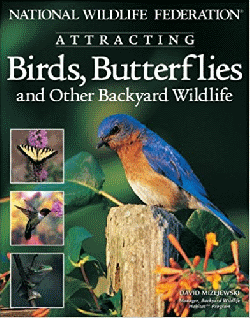
National Wildlife Federation 2004
Cover Courtesy and Copyright Creative Homeowner a.k.a Fox Chapel Publishing
The simple answer is to keep things in line with restoring their natural habitat by providing food, water, shelter and places to raise their young.
The best way to restore, or maintain, a successful and healthy ecosystem is to utilize “native” plants. Natives are basically the plants that would grow in the area naturally. Although some exotic transplants from other locations can be stunning to look at, and may even grow successfully in a new environment, wildlife may not be able to adapt to its use as food or shelter. In fact, those foreign plants may actually spread and push out native plants and prevent songbirds and pollinators from entering your yard. Some of them also carry diseases for which our native plants have no immunity.
Scientific studies have proven that having a diversity of plant species in an area improves the health of all those plants…..if they are natives to that locale. And healthy plants provide healthy benefits for wildlife and people. Westerners should reconsider the idea of having a monoculture lawn of Kentucky Bluegrass that is so common in the Eastern parts of the U.S.
What are some factors that determine which native plants will succeed in your area?
Learn about the elements and nutrients in your soil by using simple soil-test kits which can be purchased at Garden Centers.
Can you obtain plants that will succeed in natural soils, or will you have to supplement it with chemical fertilizers? Are you willing to deal with the potential effects of additional chemical use?
Some plants require mostly sunny areas, some shady, and some a combination of both.
What is the climate like in your locale? Don’t confuse this with weather. Climate is the average condition of a place for twenty years or more.
What is the normal precipitation pattern? Will you have to supplement that with irrigation? Can you afford that if your area is suffering from drought conditions?
Make certain that you check the cold-hardiness zone of plants you purchase. Some commercial retail stores will sell whatever they are shipped, often knowing that those plants will never survive in your area.
For a list of Utah native trees, shrubs, and flowers, research:
* Utah Native Plant Society at unps.org
*Utah State University Extension Center for Water-Efficient Landscaping at cwel.usu.edu
And you can always “Google” Native Plants + Utah.
This is Ron Hellstern, and I am Wild About Utah.
Credits:
Images: Courtesy & Copyright 2004 NWF.org
Audio: Courtesy and Copyright Kevin Colver
Text: Ron Hellstern, Cache Valley Wildlife Association
Additional Reading
D. Mizejewski, Attracting Birds, Butterflies and Other Backyard Wildlife (Reston, VA: National Wildlife Federation/Fox Chapel Publishing, 2004). https://www.amazon.com/National-Wildlife-Federation-Attracting-Butterflies/dp/1580111505/
Publisher Website: https://foxchapelpublishing.com/national-wildlife-federation-r-attracting-birds-butterflies-backyard-wildlife.html
Certify Your Wildlife Habitat, National Wildlife Federation, Accessed 20 July 2017, https://www.nwf.org/Home/Garden-For-Wildlife.aspx
Certify: https://www.nwf.org/Garden-For-Wildlife/Certify.aspx
Creating Landscapes for Wildlife… A Guide for Backyards in Utah, Written by Sue Nordstrom and Illustrated by Kathlyn Collins Department of Landscape Architecture and Environmental Planning, Utah State University with Margy Halpin, Utah Division of Wildlife Resources; Second Printing 2001,
Updated for the Utah Division of Wildlife Resources, by Frank Howe, DWR Avian coordinator; Ben Franklin, DWR–Utah Natural Heritage Program botanist; Randy Brudnicki, DWR publications editor; and landscape planning illustrations by Stephanie Duer.,
Published by:
State of Utah Natural Resources, Division of Wildlife Resources,
Utah State University Cooperative Extension Service and
Utah State University Department of Landscape Architecture and Environmental Planning;
1991 updated 2001 https://wildlife.utah.gov/pdf/landscapingforwildlife.pdf
